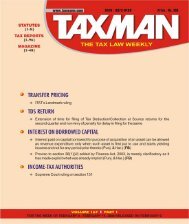CPT V24P7-Art1 (Content).pmd - Taxmann
CPT V24P7-Art1 (Content).pmd - Taxmann
CPT V24P7-Art1 (Content).pmd - Taxmann
You also want an ePaper? Increase the reach of your titles
YUMPU automatically turns print PDFs into web optimized ePapers that Google loves.
Direct Tax Laws<br />
5.10 The ITAT Bench in the case of IAC v.<br />
Panipat Co-operative Sugar Mills Ltd. [1983]<br />
3 ITD 734 (Chd.) - Case that out of four items<br />
of additions made to the income of the assessee,<br />
penalty for concealment under section 271(1)(c)<br />
of the Act was levied at assessment stage.<br />
The Commissioner of Income-tax (Appeals)<br />
deleted the penalty imposed on three items<br />
but sustained the penalty imposed on the<br />
fourth item. In the second appeal by the revenue<br />
contesting the deletions, the assessee, on the<br />
strength of rule 27 of the ITAT Rules, 1963,<br />
raised before the Tribunal for the first time<br />
that a different finding was warranted qua<br />
the penalty sustained.<br />
The Tribunal held as follows-<br />
636<br />
“The right granted to the respondent under<br />
rule 27 of the ITAT Rules, 1963 is limited.<br />
All that the respondent can do is to support<br />
the order of the appellate authority as a<br />
respondent, who has neither come in appeal<br />
nor in cross-objection. He cannot ask for<br />
a finding different from that of the first<br />
appellate authority on the basis of rearguing<br />
the grounds rejected by the first<br />
appellate authority. The contentions raised<br />
by the assessee against the levy of penalty<br />
were, therefore, not sustainable.”<br />
5.11 The Delhi High Court in CIT v. Edward<br />
Keventer (Successors) (P.) Ltd. [1980] 123 ITR<br />
200 - Case was that the Assessing Officer had<br />
treated certain share transactions as sham and<br />
collusive and, therefore, disallowed the losses<br />
claimed and, consequently, disallowed the interest<br />
admitted by the assessee relating to these<br />
transactions. The first appellate authority treated<br />
these transactions as genuine but considered<br />
the prices to be inflated. He, therefore, computed<br />
a profit and as a logical corollary, allowed the<br />
interest substantially (except to the extent of<br />
inflation found by him). The assessee filed an<br />
appeal before the Tribunal and urged that the<br />
profit computed by the first appellate authority<br />
was wrong and prayed for its deletion. In<br />
other words the first appellate authority had<br />
given two findings, one against the assessee<br />
August 1 to 15, 2012 u TAXMANN’S CORPORATE PROFESSIONALS TODAY u Vol. 24 u 16<br />
and the other against the department. The<br />
Tribunal deleted the profit estimated by the<br />
first appellate authority and so the Revenue,<br />
invoking rule 27 of the ITAT Rules, 1946 argued<br />
that when the Tribunal had deleted the addition<br />
made by the first appellate authority the assessee<br />
would not be entitled to the benefit of any<br />
deduction by way of interest on loans said to<br />
have been obtained for purchasing the shares.<br />
The Tribunal, however, did not accede to the<br />
contention of the Revenue. It was pointed out<br />
by the Tribunal that all that a respondent in<br />
an appeal could do was to support the decree<br />
on any of the grounds decided against him in<br />
the lower court, but that the respondent could<br />
not make out a case for a decree for the same<br />
amount by attacking the decree in respect on<br />
a right decided against him. Referring to certain<br />
decisions under order 41, rule 22 of the Code<br />
of Civil Procedure, 1908 the Tribunal rejected<br />
the arguments on behalf of the revenue and<br />
declined to maintain the addition to the extent<br />
of the relief granted by the first appellate<br />
authority in assessee’s favour, in the interest<br />
account. The High Court, on reference, held<br />
that “It could not have assailed the latter in<br />
appeal without attacking the findings on the<br />
first also. To say, in such circumstances, that<br />
the department could not seek to uphold the<br />
order of the first appellate authority on this<br />
subject-matter would virtually amount to denial<br />
of natural justice to it which is not the object<br />
of the relevant statutory provisions. Moreover,<br />
even if the department’s grounds ultimately<br />
succeed on merits, the assessee would not be<br />
adversely affected and could not be in a worse<br />
position than if it had preferred no appeal at<br />
all.”<br />
The High Court, ultimately, held that the Tribunal<br />
should have entertained the ground adduced<br />
by the Revenue being an inter-connected one<br />
and then should have disposed of the appeal<br />
in the light of its decision thereon.<br />
5.12 The Allahabad High Court in the case of<br />
Kanpur Industrial Works v. CIT [1966] 59 ITR<br />
407 - The decision in the case succinctly explains<br />
the rights of the assessee to invoke rule 27 of











![“FORM NO. 3CEB [See rule 10E] Report from an ... - Taxmann](https://img.yumpu.com/45480232/1/190x245/form-no-3ceb-see-rule-10e-report-from-an-taxmann.jpg?quality=85)





